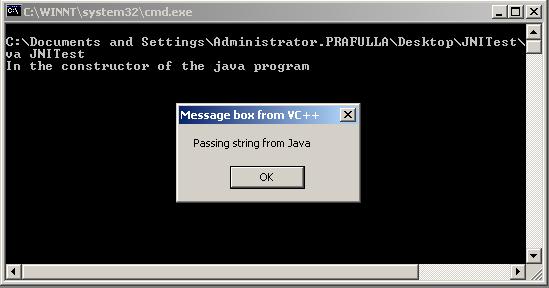출처 :http://www.codeproject.com/dll/JNITest.asp
JNI is my favourite programming framework in Java; it gives you freedom to use natively created code. For example, if you want to use any Windows API (i.e. dll) from your Java code, you can use JNI. The most popular advantage of Java is platform independence. However, sometimes this feature makes it very difficult to integrate Java programs with native platforms. For example, in our project we are using MSM Q (Microsoft Messaging Que) for a queuing mechanism to maintain messages (to avoid loss of messages) before writing them to the database. Microsoft is providing MSM Q API which is a Windows' API. But our program produces messages is in Java, and Java can't directly access such VC++ API (dll). So we have decided to make an intermediate DLL which will be work as bridge between Java and VC++ (we have used the technology Java Native Interface, or JNI). Before proceeding further, you should know / be familiar with some terms. So let's start. First, write your Java program with a declaration of native methods. The following code is from the source sample: In above code we have declared Perform the following: Execution of the above will produce the file JNITest.h. This .h file contains VC++ equivalent names of native methods declared in our Java code We are almost half-way done. Now create a simple dll project in Visual Studio (or any other win32 IDE) and add above .h file to the project. Add the path of your JRE\INCLUDE folder to your includes to get include file jni.h. Now you will find the names of the methods declared in the .java file in somewhat different manner. In the above case you will get: Here, the third argument is your argument from Java program. You can convert it to the native form as: Here you can use Releasing the string after use is compulsory, and is not automatic. JNI activities are presumed to be external to JVM, so it will not throw any kind of exception which could be caught in Java code. If you forget to release the string before leaving the function, this could result in the crashing of your JVM. You can release the string using the function The whole code would be look like this: Now you are free to do anything with Windows (or VC++) components - you can now access any Windows API. Build the dll and place it in your Java program's folder (the folder which contains your .class file). Now run your Java program. Note: If you get UnSatisfiedLinkError, Check your method signature (prototype). It must be as same as provided in the .h file Using JNI, you can access various facilities provided by Windows from Java programs.
Introduction
![]() Collapse
Collapsepublic class JNITest
{
static
{
System.loadLibrary("JNITest"); // Loading dll in memory
}
native void showMessage( String str); // Declaring native method
public JNITest()
{
System.out.println( "In the constructor of the Java program" );
}
public static void main( String s[] )
{
JNITest JNT = new JNITest();
JNT.showMessage("Passing string from Java");
}
}
showMessage method which is native, and called it w.r.t. object of class JNITest.Creating JNI DLL
![]() Collapse
CollapseJNIEXPORT void JNICALL Java_JNITest_showMessage(JNIEnv *, jobject, jstring);![]() Collapse
Collapseconst char *strS1 = env->GetStringUTFChars( s1, 0);
strS1 in the program as a C++ string. In the demo program I have used it to display it in Messagebox. There are many methods ofJNIEnv by which we can convert various types of data from Java to C++.ReleaseStringUTFChars:![]() Collapse
Collapseenv->ReleaseStringUTFChars( s1, strS1);![]() Collapse
CollapseJNIEXPORT void JNICALL Java_JNITest_showMessage(
JNIEnv * env, jobject job, jstring str )
{
const char *strMsgPtr = env->GetStringUTFChars( str , 0);
//Converting string to C++ character pointer
MessageBox( 0, strMsgPtr,"Message box from VC++ ", 0 );
//Using the string
env->ReleaseStringUTFChars( str, strMsgPtr);
// Releasing the string ( character pointer )
}
'Java' 카테고리의 다른 글
| Java SE Application Design With MVC (0) | 2007.03.24 |
|---|---|
| Reflections on Java Reflection (0) | 2007.03.17 |
| 클래스 로딩 문제 분석하기, Part 1: 클래스 로딩과 디버깅 툴 소개 (0) | 2007.03.10 |